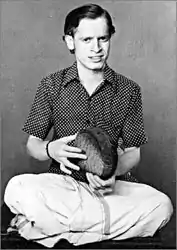G. Harishankar
Govinda Rao Harishankar, (India, June 10, 1958 in Chennai – February 11, 2002 in Chennai) was an Indian player of the kanjira, Khanjira or Khanjari, a tambourine-like frame drum used in the Carnatic music of South India. He is the only kanjira player to be awarded the Sangeet Natak Akademi Award, the highest national recognition given to performing artists.

Profile
Harishankar received his initial training under his father Govinda Rao. (The Malayalam film singer and classical vocalist Govind Rao was a different person.) He later learnt under Ramanathapuram C. S. Murugabhoopathy and then under Palghat Mani Iyer. He was a staff artist of the All India Radio, Chennai. Some of his best performances in albums were with the Sruthilaya group along with Karaikudi R Mani on the mridangam, T V Vasan on the ghatam, and Srirangam Kannan on the morsing. He performed on several albums including Laya Chithra, Sruthilaya, and Grand Finale. He is considered by many as the greatest kanjira performer to date. 'Harishankar style of Kanjira playing' has become the benchmark for Kanjira playing which been hugely followed & adapted by all Kanjira players worldwide.
He had albinism. He died of lung cancer when he was just 43 years old.[1]
G. Harishankar's main disciples are C. P. Vyasa Vittala, Bangalore Amrit & Nerkunam Sankar. They are performing in concerts regularly. They have been training many students & spreading the tradition to the next generations.[2][3][4]
References
- "G Harishankar: Man who took kanjira to the world". The Times of India. 21 June 2022. ISSN 0971-8257. Retrieved 21 July 2023.
- " The Kanjira falls silent", by Aruna Subbiah, KutcheriBuzz Magazine (online edition); February 20, 2002; Madras
- "G. Harishankar — Khanjira Maestro Without Equal Archived 17 November 2006 at the Wayback Machine", by Manna Srinivasan, Sruti magazine #210 (online edition); March, 2002; Chennai
- Centers, S. (2005). "Famous People with Albinism". SARA-Foundation.com. Campbell, California: Supporting Albinism Research and Awareness. Archived from the original on 23 April 2008. Retrieved 26 April 2008.